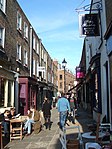Noel Road
1841 establishments in EnglandStreets in the London Borough of Islington

Noel Road is a street in Islington, London. It runs roughly west to east from Colebrooke Row to St Peter's Street (and crosses Danbury Street), and the houses on the south side back onto the Regent's Canal. It was developed in 1841; and until 1938 was two streets, Noel Street and Hanover Street. Many of its buildings are listed with Historic England. Former residents include the novelist George Gissing, artist Walter Sickert, playwright Joe Orton, and the author Nina Bawden. In 1967, Orton was murdered in his apartment at 25 Noel Road by his long-term partner Kenneth Halliwell, who committed suicide shortly after.
Excerpt from the Wikipedia article Noel Road (License: CC BY-SA 3.0, Authors, Images).Noel Road
Noel Road, London Clerkenwell (London Borough of Islington)
Geographical coordinates (GPS) Address Nearby Places Show on map
Geographical coordinates (GPS)
| Latitude | Longitude |
|---|---|
| N 51.53319 ° | E -0.09988 ° |
Address
Noel Road 56
N1 8BD London, Clerkenwell (London Borough of Islington)
England, United Kingdom
Open on Google Maps










